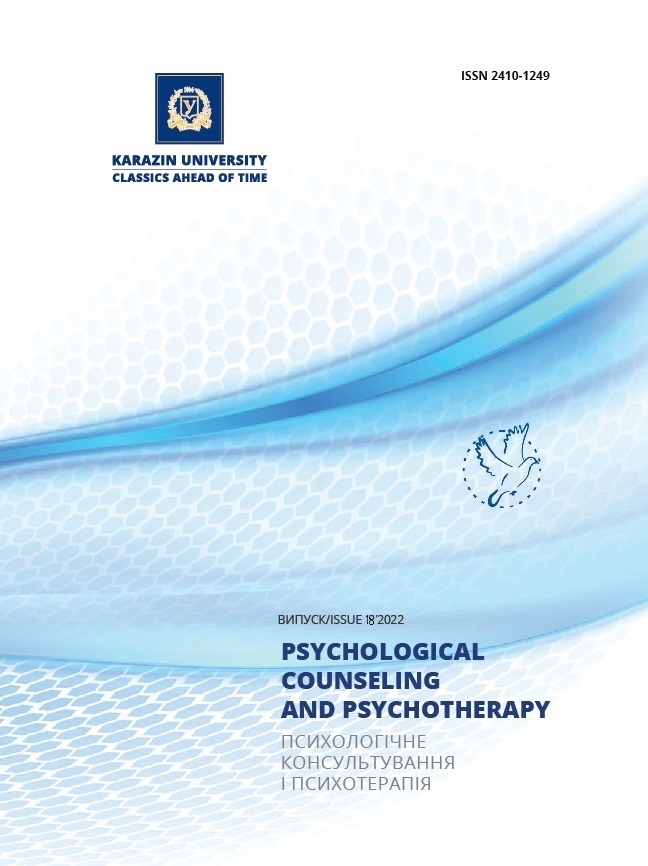Дослідження ефектів субсенсорного впливу на систему асоціацій У хворих на депресивні розлади
Анотація
Статтю присвячено актуальній проблеми вивчення ефектів неусвідомленого сприйняття й переробки підпорогових зорових вербальних стимулів. Визначаються певні методичні проблеми, що виникають при дослідженнях швидкоплинних перцептивно-інформаційних процесів. Наголошуються суттєві відмінності в перебігу таких процесів у здорових осіб та у хворих на афективні, перш за все, депресивні розлади. Надається опис методики субсенсорного формування асоціацій, розробленої для дослідження ефектів впливу підпорогових зорових вербальних стимулів на психосемантичні структури особистості. Наводяться дані щодо обстеження вибірки з 69 осіб за допомогою новітньої методики. До вибірки увійшли 37 (53.62 %) осіб, що страждали на різні форми депресивних розладів, і 32 (46.38 %) здорові особи контрольної групи. Показано, що надкоротка екпозиція субсенсорних вербальних стимулів з позитивним психосемантичним забарвленням, демонстрованих водночас з концентрацією уваги досліджуваного на супрасенсорному таргетному слові, призводить до суттєвого зростання позитивних асоціацій з цим словом. Відмічається, шо подібні ефекти у депресивних хворих є більш вираженими, ніж у здорових осіб. Робиться висновок, що отримані дані відкривають нові перспективи в контексті розробки сучасних персоніфікованих психокорекційних програм.
Завантаження
Посилання
Lumer, C. (2019). Unconscious Motives and Actions - Agency, Freedom and Responsibility. Frontiers in psychology, 9, 2777. https://doi.org/10.3389/fpsyg.2018.02777
Peters, M., Kentridge, R. W., Phillips, I., & Block, N. (2017). Does unconscious perception really exist? Continuing the ASSC20 debate. Neuroscience of consciousness, (1), nix015. https://doi.org/10.1093/nc/nix015
Smirnov, I.V. Psychoecology. M.: Refrigeration business, 2003. - 336 p. (in Russian)
Libet, B. Mind time: The temporal factor in consciousness, Perspectives in Cognitive Neuroscience. — Harvard University Press, 2004. — ISBN 0-674-01320-4.
Yaden, D. B., Eichstaedt, J. C., & Medaglia, J. D. (2018). The Future of Technology in Positive Psychology: Methodological Advances in the Science of Well-Being. Frontiers in psychology, 9, 962. https://doi.org/10.3389/fpsyg.2018.00962
Greenwald, A.G. (1992). New look 3. Unconscious cognition reclaimed. Am Psychol. Jun, 47(6), 766-79. https://doi.org/10.1037/0003-066x.47.6.766
Elgendi, M., Kumar, P., Barbic, S., Howard, N., Abbott, D., Cichocki, A. (2018). Subliminal Priming - State of the Art and Future Perspectives. Behav Sci (Basel). 30, 8(6), 54. https://doi.org/10.3390/bs8060054
Lutsik V.L. (2002). Prospects for the experimental psychosemantic approach in medical psychology. Bulletin of Kharkiv University. Ser. "Psychology". (550), 177-181. (in Russian)
World Health Organization. (2020). Depression. https://www.who.int/news-room/fact-sheets/detail/depression
Maruta, N.O., Linska K.I. (2019). Method of objective assessment of therapy for patients with depression. Ukrainian Herald of Psychoneurology. 27(4), 35-44. (in Ukrainian)
Shestopalova, L.F., Lutsyk, V.L. (2021). Threshold and semantic characteristics of rapid visual-perceptual processes in patients with affective disorders. Psychiatry, neurology and medical psychology. (16), 66 72. (in Ukrainian)
Shestopalova, L.F., Lutsyk, V.L. (2021). Development and testing of experimental psychological methods for the study of unconscious visual and perceptual processes. Psychological counseling and psychotherapy. (14). 50-56. (in Ukrainian)
Bruner, J. (2001). On perceptual readiness. Reader in general psychology. Issue III. Subject of Cognition: Textbook for students of special departments of faculties of psychology of higher educational institutions in the specialty 52100 and 020400 - "Psychology". - M .: Educational and methodological collector "Psychology", 120-125. (in Russian)
Breitmeyer, B.G., Ogmen, H. (2007). Visual Masking Scholarpedia. 2(7), 3330.








